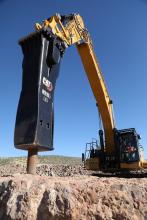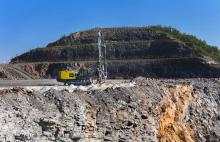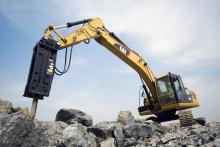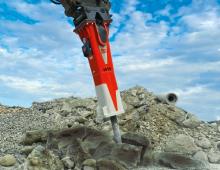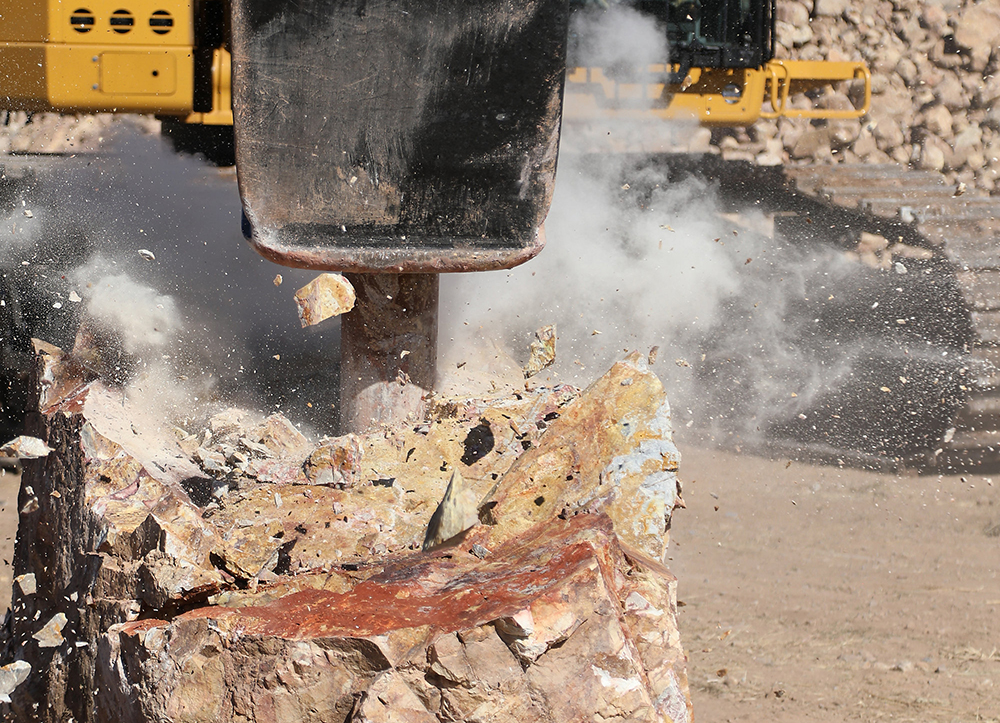
Caterpillar has launched the new H190 S and H215 S performance series hammers, built for high production on large excavators. Cat says the two new hammers – now available in Europe and the Americas – deliver consistent breaking power, and their extremely efficient operation cycle results in less waste from internal heat for more power delivered to the tool.
With piston and tool matched in diameter and mass, Cat says the two new hammers offer increased power transmission frequency. Operators can switch power mode from high frequency/low power to low frequency/high power, giving the ability to fine-tune power to the material being broken.
Cat adds that the new H190 S and H215 S hammers, in addition to being powerful, also enable operator comfort and machine protection with their proprietary buffering material that dampens vibration feedback to the carrier. Automatic shut-off that prevents blank firing and hammer damage can be temporarily turned off for horizontal and overhead operation in tunnelling and mining applications. The flexible hammers can be configured for joystick or pedal control to suit the operator’s preference when working in quarry, demolition and general construction applications.
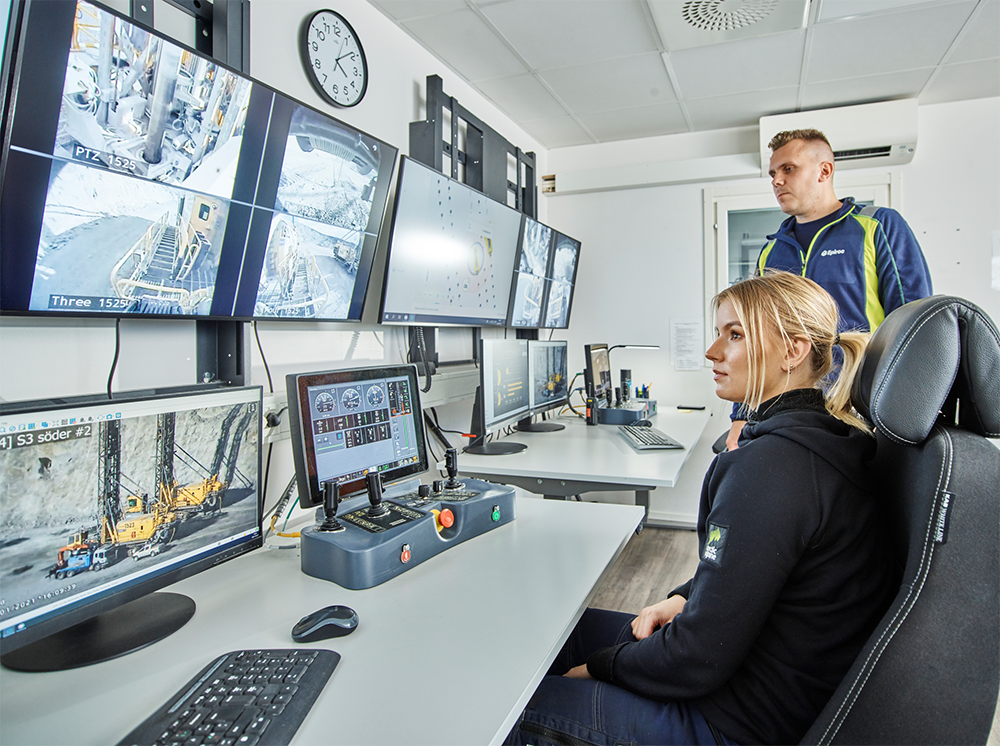
Tuned to deliver the highest possible work rates with Cat next-gen excavators, the new H190 S hammer is sized for operation on Cat 349 through 374 models, while the larger H215 S is designed for the 374 and 395. Auto Stop instantly terminates hammering when the tool breaks through material, preventing damage to both the carrier and hammer.
Next-gen excavators automatically recognise the H190 S and H215 S hammers and prompt operators to select the correct tool programme.
Protecting the cab and keeping the attachment in predefined operating areas at the jobsite, the new hammer dimensions are included in Cat E-Fence technology. Cat says that through its Product Link excavator technology, users can quickly locate the hammer attachment using the Cat App. Hammer pressure and flow rates are viewed on the in-cab monitor and can be configured manually or automatically using the touchscreen display.
All daily checks and routine service can be performed without removing the new H190 S and H215 S hammers from the carrier, saving time. Steady internal gas pressure throughout the duration of the annual service interval is designed to eliminate the need for frequent charge inspection. The lower bushing’s rotatable design optimises service life to minimise parts costs, while the bushing can be quickly serviced in the field using hand tools.
A standard on-board autolube system provides continual greasing during hammer operation to improve attachment longevity. For operating in extreme environments, an optional wear package protects the hammer housing from damage.
Japanese multinational Komatsu has expanded its range of hydraulic breakers with the new V-series, which is designed to be fully variable for helping to maximise productivity and lower cost per tonne.
Used in a variety of rock and concrete demolition applications from scaling a tunnel, to running a pedestal-boom on a quarry, or tearing out reinforced concrete abutments, breakers are essential tools. Designed and tested for compatibility with Komatsu excavators from the PC210 up to the PC490, Komatsu says the new JMHB-V breaker series helps customers achieve excellent impact energy and performance in a variety of demolition applications.
With minimal wasted energy and subsequent higher operating efficiency, Komatsu adds that the 100% hydraulic-fired V-series breakers modulate their impact force and frequency with up to 16 working positions to match most applications’ requirements. Designed to help maximise productivity while helping lower cost per tonne, the breakers are also fitted with an innovative energy-saving recovery valve that recuperates energy to drive efficiency.
Depending on the application’s hardness, V-series breakers automatically select the best piston stroke length and speed. By adjusting to either hard material, with long and powerful strokes, or to softer material, with shorter, faster strokes, the breakers are designed to achieve high production output, with little wasted impact energy.

To help owners get more from their investment, Komatsu says the V-series breakers have several valuable standard features, including automatic greasing, advanced blank-firing protection, swivel hose couplings and heavy-duty housing. The shock-dampening systems in the form of upper and lower suspensions help reduce the risk of cracking excavator booms and breaker housings, while the mounted standard automatic lubrication feature helps guard against contamination caused by dust and debris.
For greater operator comfort, suspensions with rubber/poly components help absorb impact and reduce vibrations through the boom. The completely enclosed sound-dampening housings reduce the amount of noise generated when compared to open-style breakers, which Komatsu says offers customers a solution that addresses noise ordinances in urban applications.
To support regular maintenance of breakers, inspection kits are included with gauges to measure wear on all critical components. Additionally, these breakers are backed by the Komatsu North America Attachment Division, a dedicated hydraulic attachments sales and service team that supports Komatsu distributors. These specialists are factory-trained and experienced with installation, operation, service and rebuilds.
Sweden-based Epiroc has partnered with ASI Mining to introduce Mobius for Drills, a new platform to convert drilling data into useful, actionable information in operations including surface mining.
Featuring embedded artificial intelligence, Epiroc says the user-friendly Mobius system enables multi-vehicle command, control and monitoring to maximise productivity and safety.
“We think of it as a tool to directly support making quick and effective interrelated decisions,” says Tyler Berens, automation director, surface mining at Epiroc’s surface division. “Mines can get greater productivity and economies of scale as a single operator controls multiple remote and autonomous vehicles. Mobius for Drills is designed to tie the whole value chain together.”
Mobius for Drills displays data in an easy-to-use layout to map drill usage, evaluate statistics, track consumables and compare planned outcomes against actual results.
“Mobius for Drills is an ideal management tool because of all the support it provides in decision making, but Mobius for Drills also helps with driller training, so it is useful for the whole workforce,” adds Christopher Blignaut, product owner - data solutions, Epiroc surface division.
By providing a single platform for all stakeholders within the drilling operation, Epiroc says users can quickly navigate the information, filter it to their needs and streamline the decision-making process, day-to-day or over time.
A claimed added value to Mobius for Drills is its ability to work across fleets with drills from multiple manufacturers, condensing all sources of information. It can be used as a fleet management system or integrate with a mine’s existing system.
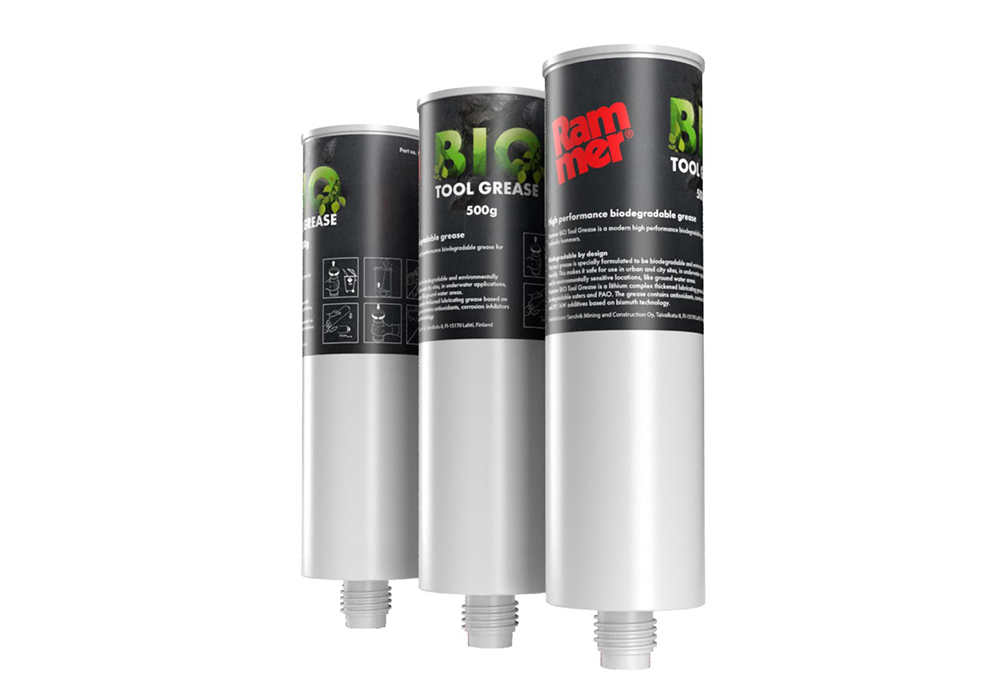
Mahmood Hassan, engineering project manager – automation at Epiroc’s surface division, comments: “Mobius for Drills enhances engagement of all stakeholders with the drilling process. It provides valuable insight at each stage of the drilling process through a drill plan builder for planning, situational awareness for drill controllers and reporting for supervisors. It is a scalable product, which accommodates evolving needs of a mine.”
The platform imports drill plans, monitors drilling and creates the reports over a secure system on-site or remotely. It supports manned operations, teleoperation, semi- and fully-autonomous modes and covers applications from drill and blast through to autonomous haulage systems.
In its aim to cultivate more environmentally friendly ways of operation, Sandvik says it has launched a new BIO Tool Grease that is designed to offer a greener alternative for the upkeep of hydraulic hammers.
The biodegradable grease is the first product in the Swedish company’s Green Range, and can be used with Sandvik hammers and those of its Finland-based brand, Rammer. It is specially formulated to be more environmentally friendly and safe for use in environmentally sensitive areas such as groundwater locations.
The lithium complex-thickened BIO Tool Grease is based on biodegradable esters and polyalphaolefin (PAO) and contains corrosion inhibitors, antioxidants, and bismuth technology-based extreme pressure/anti-wear additives (EP/AW) additives. The special formulation makes the grease suitable for both high and low temperature applications and provides excellent wear protection and good load-carrying capacity. In addition, its complex soap structure ensures great mechanical stability, prolonging re-lubrication intervals and enhancing performance in vibrating housing.
BIO Tool Grease is supplied in three sizes: 400g, 500g and 18kg. The 500g cartridge is suitable for Ramlube II automatic tool greasing device, making it easy and quick to replace cartridges.
Jouni-Pekka Hiltunen, product line manager at Sandvik Rock Processing Solutions, comments: “When developing this new BIO Tool Grease, our two most important criteria were environmental friendliness and lubricity, and the new grease meets both of these excellently. Hammer applications place very high demands on greases, and the new grease fits perfectly into our Ramlube II automatic tool greasing system.”
Arto Halonen has been appointed as CEO of Finland-based Robit Group. He takes over as head of the drilling products and technology company from Tommi Lehtonen who stepped down in March 2022.
Halonen, M.Sc. (Eng) and M.Sc (Econ.), has been employed as Robit's chief financial officer and chief operations officer since March 2020.
He previously worked at Metso Minerals from 2018 to 2020 as vice president crushers, at Metso Inc in 2017 as vice president strategy and business development, and at Metso Minerals from 2015 to 2016 as vice president global sales & marketing.
Harri Sjöholm, chairman of the Robit board of directors, commented on Lehtonen’s departure: “I would like to thank Tommi both on my own and on behalf of the board of directors for his input for Robit and the company’s growth, exceeding net sales of €100m. We wish Tommi all the best in his future duties.”
Robit has recently committed to new sustainability KPIs (key performance indicators) and is asking the company’s stakeholders to do the same.
The company says it has always had sustainable practices, such as sourcing materials from responsible partners, as well as setting a high priority on employees’ health and safety. Recently, however, it has been in the process of doubling down on its sustainability efforts and setting clear objectives for these practices, based on a common vision created through extensive cooperation between the management and the employees.

With the launch of the ESG (Environment, Social, Governance) roadmap in September 2021, the ESG practices of the company have been refined and further defined and Robit’s actions have been divided into four key areas: Sustainable partnerships; CO2 emission reduction in the value chain; healthy and happy workplace; efficiency throughout product lifecycle.
The company says the aim of these four pillars is to tackle sustainability issues from several directions at once.
Even though the concrete KPIs for these key areas were launched only last September, the company says there are already several actions taken and some significant results that have been reached.
Robit aims to have a minimum of 90% of its supplier spend coming from suppliers who have committed to Robit’s supply chain policy. The result at the end of 2021 was already at 79%.
A first step towards CO2 emission reduction was taken by building a calculation tool to recognise Scope 1 and 2 CO2 emissions caused by Robit’s own operations. The company says it will also increase the share of green energy in its factories, with the first changes having been implemented at its Australian factory in October 2021.
For a healthy and happy workplace, the KPI is to target zero lost-time incidents, based on LTIF (lost-time incident frequency). In 2021 the result was 2.1, which is already a significant improvement from 4.2 in 2020. In January 2022, Robit reached LTIF of 0.0.
To increase efficiency throughout product lifecycle, Robit has set a KPI of providing at least 1,000 hours of consultative sales training annually to the sales and technical personnel of the company and its distributors. Additionally, Robit has set the target to achieve over 90 percent waste-recovery ratio in its factory locations. The 2021 results for these were 921 hours and 87%, respectively, bringing the company very close to reaching these milestones.

